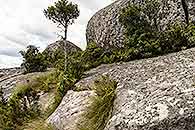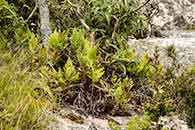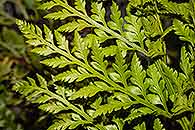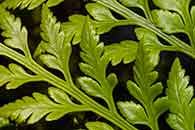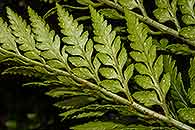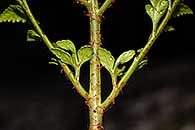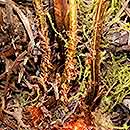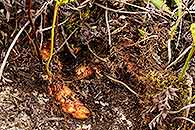Rumohra adiantiformis (G. Forst.) Ching
Synonyms |
Polypodium adiantiforme G. Forst. |
|---|---|
Common name |
Knysna fern |
Description |
Rhizome widely creeping above ground, up to 10 mm in diameter; rhizome scales up to 16 × 5.5 mm, margin entire, reddish-brown, ovate to lanceolate, hairpointed, dense. Fronds spaced, very coriacous, erect, rigid, shiny above, paler below. Stipe up to 50 cm long, matt pale brown, grooved above, set with brown ovate scales towards the base, subglabrous with age. Lamina deltate to broadly ovate in outline, basal pinnae basiscopically developed,tripinnatifid to quadripinnate, apex pinnatifid-deltate, up to 50 × 35 cm. Pinnules pinnatifid to dentate, ovate in outline, base unequally cuneate, upper surface glabrous, lower surface sparsely set with a few scales along the veins. Rhachis stramineous to brown, grooved, costae and costules scaly in young fronds. Sori round, large, usually one per lobe; indusia c. 2.2 mm in diameter, round, thick, coriaceous, peltate, glabrous, shed at maturity. |
Notes | The secondary rhachis and costae do not have raised edges on the upper surface, the fronds are very leathery, the rhizome creeps above ground and is densely set in papery, rusty coloured scales. |
Derivation | adiantiformis: shaped like Adiantum; unclear reference since the fronds of the species of the genus Adiantum do not compare to Rumohra adiantiformis. |
Habitat | Among boulders in rocky outcrops in montane grassland, shaded forest floors and forest margins, scrub forest on rocky slopes. |
Distribution worldwide | Africa, Madagascar, Comoro and Mascarene islands, Australia, New Zealand, Polynesia, South and Central America. |
Distribution in Africa |
|
Growth form |
Epiphytic, lithophytic, terrestrial. |
Literature |
|
